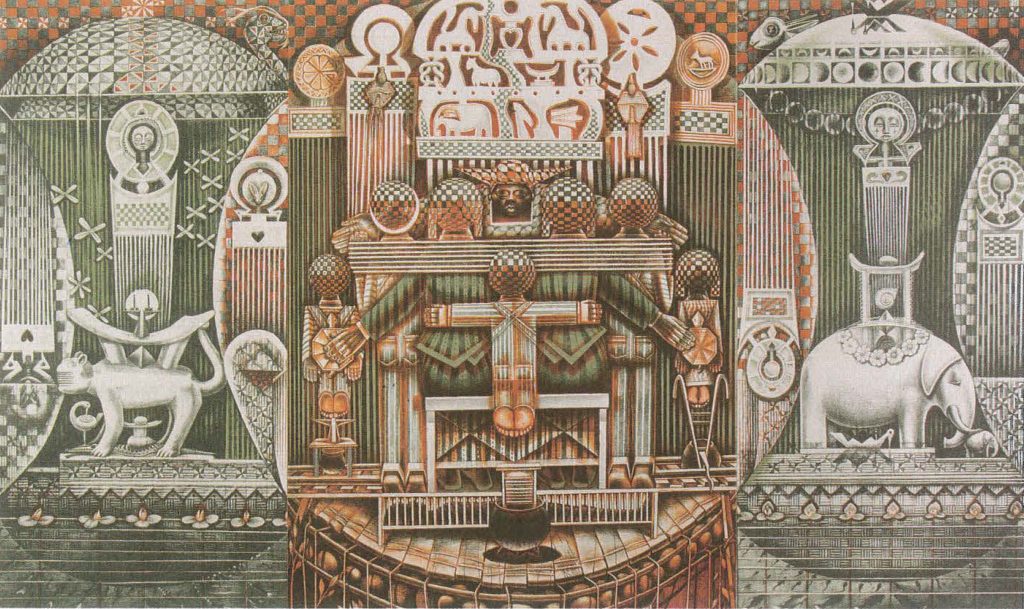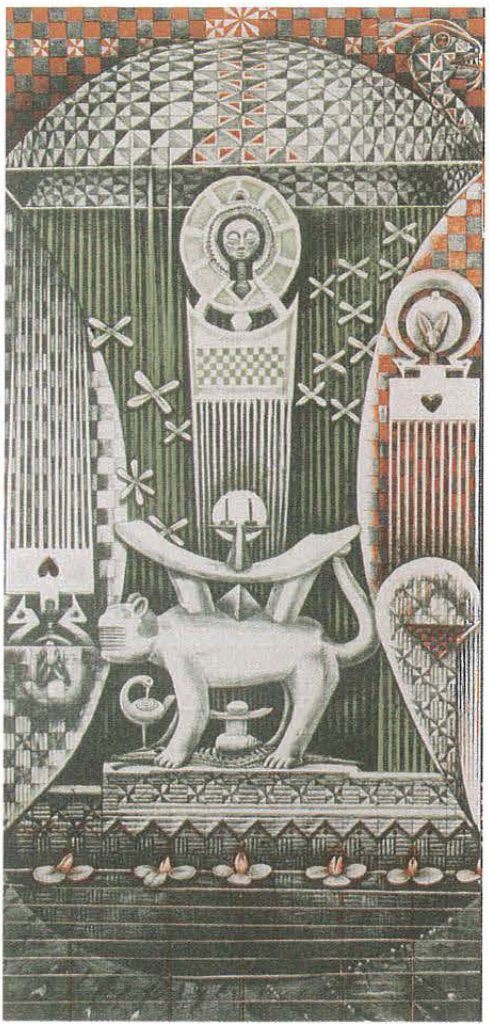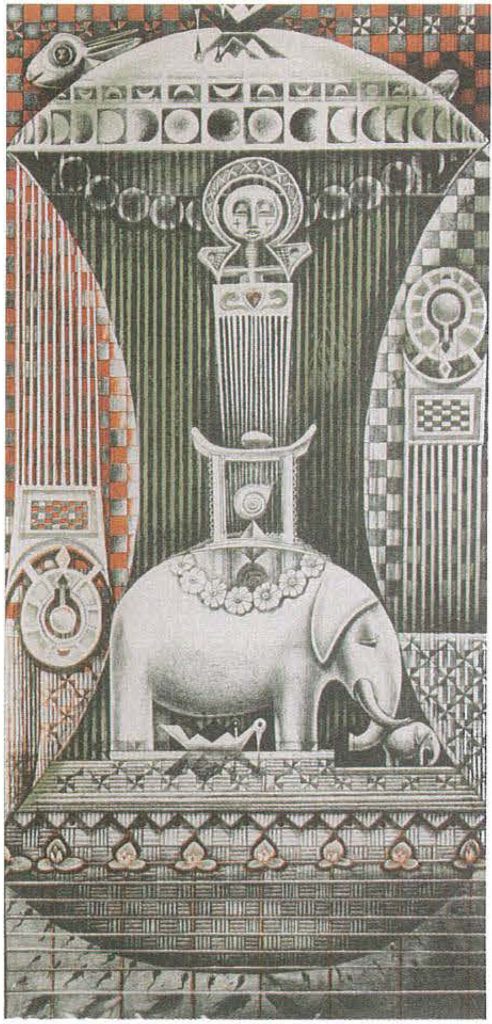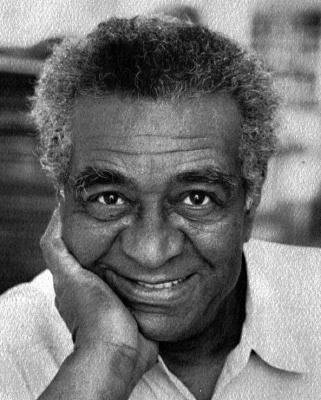
Family Ark
John Biggers
- 1992
- Color offset lithograph triptych
- Image/sheets (three joined): 29¾ x 49½ "
- Center panel (image/sheet): 29¾ x 21 9/16"
- Right panel (image/sheet): 29 ¾ x 13 15/16"
- Side panels: 2009-61-7a,b
- Center panel: Philadelphia Museum of Art: Purchased with the Print Revolving Fund,
- 1999-122-2
About the Print
John T. Biggers researched some of Sub-Saharan Africa’s visual traditions. Family Ark, 1992, is a grand story divided into three sections—a triptych—designed by Biggers to be shown all together, with the center panel on its own, or with the side panels paired together. Aspects of symmetry, geometry, and pattern can be found everywhere. One of the prints is made up of monochromatic sheets that are only printed in gray and green. Another uses additional earth colors to create six different presentations of the same print. Biggers’ use of cross-cultural motifs such as the traditional washboard and three-legged iron pot, altar, and animals such as turtles, snakes, and elephants is symbolic and serves as a metaphor for life, death, and renewal in African and African American cultures.
—Adapted from Brandywine Workshop and Archives records and “Fresh, Human and Personal: Signature of Brandywine Workshop,” Three Decades of American Printmaking: The Brandywine Workshop Collection (Manchester, VT: Hudson Hills Press, 2004)
Let's Look
- What are some of the things you notice? Look again. What more do you see?
- Circles and ovals are repeated throughout this image. Where do you see them? How do the large circles and ovals help connect the center image with the side images?
ABOUT THE CENTER PANEL
John Biggers designed Family Ark so that the three panels of the triptych could work alone or in combination. The orange-red of the center panel helps distinguish it as the centerpiece.
Men stand, women sit, and children kneel in still reverence before an altar elaborately decorated with African motifs. Abstract and geometric, the figures seem more like icons than humans, even in their overalls and bare feet. Arms extend to include every family member. Visually, the scene is complex. Geometric shapes overlap, and circles repeat within more circles. Surfaces are lush with lines and shadows, light and dark. Patterns are drawn flat in some places but given the illusion of depth and perspective elsewhere.
In addition to mythological references, Biggers included everyday things in his work, but he gave them new meaning as symbols of life, death, and regeneration. A small wash pot and scrubboard, front and center in the foreground, may serve as a metaphor for motherhood or the act of spiritual cleansing. In Family Ark, ceremonial African combs stand like tall columns or decorative banners across the background. A soft orange-red, the color of clay from the earth, adds a sense of warmth to this sacred space.
LOOK CLOSELY AT THE CENTER PANEL
- This artwork is a triptych (composed of three sections put together). Focus on the center panel. How many figures can you find? What is their relationship? What are they doing? What makes you think that?
- Find Hathor, the Egyptian goddess of love and protection, known by her horned headdress.
- Find Osiris, the Egyptian god of the underworld and cycles of nature and regeneration. He is stretched out in his long, barred coffin.
- How do these two gods' qualities relate to the idea of family?
- Biggers placed oversized African ceremonial combs across the background of this panel (and the side panels too). Can you find five?
ABOUT THE LEFT AND RIGHT PANELS
The side panels fit together to form a diptych (two panels).
The leopard in the left panel stands with a ceremonial seat fit for royalty on its back. An elephant stands in the right panel. In African mythology, animals are often given exaggerated human traits, some good and some not. One of the animals here is associated with courage and ferocity while the other one possesses dignity, wisdom, and patience.


LOOK CLOSELY AT THE "FAMILY ARK" SIDE PANELS
- Biggers included a leopard and an elephant bearing thrones on their backs. In African mythology, the leopard is associated with courage and ferocity, the elephant with dignity, wisdom, and patience. How does the way they are drawn help express those traits?
- How do the panels come together to express ideas about family?
- How does this African American artist celebrate his African heritage in this print?

John Biggers
American
Born Gastonia, North Carolina, 1924; died Houston, 2001
Photograph by Earlie Hudnall
About the Artist
Born in Gastonia, NC, printmaker and muralist John Biggers earned a BFA, MFA, and PhD from Pennsylvania State University, University Park.
In 1949, Biggers founded what is now the Department of Visual and Performing Arts at Texas Southern University, Houston. He initiated a mural program for TSU art majors in which every senior student was expected to complete a mural on campus: there are now 114 such murals on the university campus.
Biggers was one of the first Black American artists to visit Africa to study African traditions and culture. Funded by a grant from the United Nations Educational, Scientific, and Cultural Organization (UNESCO), he and his wife traveled for six months in Ghana, Benin (then called Dahomey), Nigeria, and Togo in West Africa.
—From Brandywine Workshop and Archives records
Curriculum Connections
Suggested Topics for Art Projects, Group Discussion, and Independent Writing
Art
Symbols
Paint, draw, or print a large family tree that represents you and your genealogy. Make and attach symbols that reflect something about you and members of your immediate and extended family.
Diptych/Triptych
Create a narrative diptych or triptych that illustrates a family tradition or event. Include objects, colors, patterns, or shapes that symbolize the occasion and its significance to you. The two or three panels should relate to each other in topic and style. How will they fit together?
Language Arts
Mythology
Research the ancient Egyptian gods Hathor and Osirus. Imagine what they think about being included in Family Ark. What might they say?
In Your Opinion
"The role of art is to express the triumph of the human spirit
over the mundane and the material."
Consider John Biggers' quote about
his artwork. Does Family Ark reflect the spirit of his
words? How? If not, why not?
Social Studies
Research an Artist
Biggers honored African and African American cultural traditions from Egypt to the West Coast. Until his death in 2011, the Nigerian artist Prince Twins Seven-Seven also celebrated African culture, especially Yoruba art and music, but with a modern touch. Research why Prince Twins Seven-Seven was given the UNESCO Artist for Peace Award in 2005. What do you think Biggers would feel about this achievement?